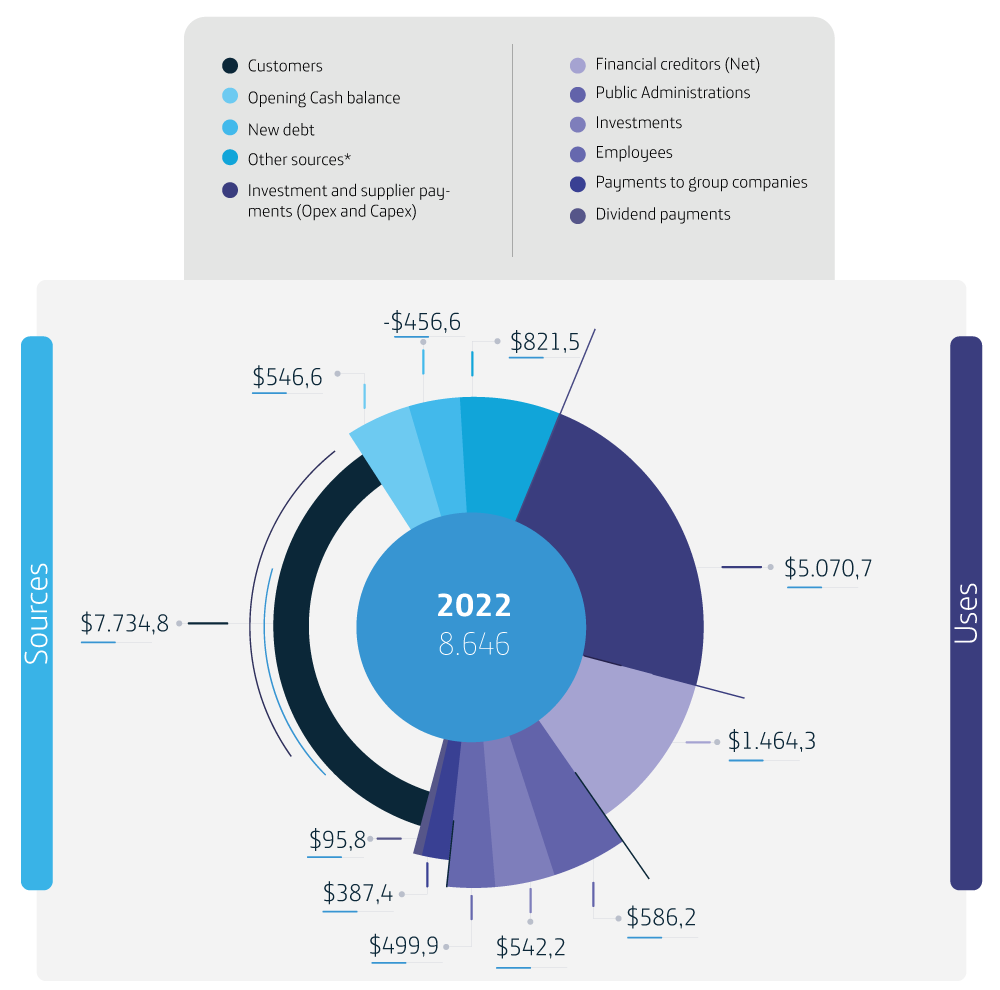Management 2022
5.1. Economic Management
(GRI 201-1)
The telecommunications sector is the main driver of the digitalization of Colombian society and the transition of the economy to the new reality. Through networks pass the lives of people, companies and governments. Digital life is life itself.
The macroeconomic impact, especially of inflation, which has not abated in the country, was exacerbated by the invasion of Ukraine, which drove commodity prices up and generated an unprecedented inflationary effect. Following the recovery of the economy’s growth in 2021, efficiencies, which are a product of digitalization, are essential to deal with new inflationary challenges. Digitalization enables finding new ways of doing things on all sides and in all segments of society, which is a significant relief in the face of inflationary headwinds.
The dynamics of the sector have driven the offer to lower tariffs in exchange for higher benefits of mobile services. However, customers do not allow themselves to be dazzled by prices alone, but rather maintain a valuable relationship with operators that provide comprehensive and quality services. In fixed telephony, competition is mainly evident in higher Internet speeds to meet the dizzying data demand for homes and businesses. Movistar is the leader in fiber optic deployment with a total of 3,6 million homes in 48 cities in the country, and a plant of 854 thousand FTTH accesses. These figures are higher than those of all other operators in Colombia. The deployment of FTTH is Movistar’s growth engine and by far the best technology available in the market.
Going forward, we find that for the ICT sector to continue being an engine of development for the well-being of society, it is essential to have a spectrum at competitive prices. This is the only way to have incentives to increasingly improve the range and quality of services and, therefore, the quality of people’s lives.
Financial management

At year-end 2022, the Company performed well toward its financial and operating goals, with strong products growth, increasing commercial activity, boosting terminal profitability, and capturing market growth opportunities.
These results are also supported by the expansion of fiber optic networks, as a result of the operation carried out with Kohlberg Kravis Roberts (KKR), that boosted the Company’s transformation and enable it to set the foundations for future business growth in the midst of a fast-changing industry and an increasingly competitive marketplace.
The Company increased to 24 million total customers with +9.3% year-on-year growth after reporting positive net profit of +2.4M in 2022. On contract, net profit in 2022 amounted to 455 thousand customers driven by the dynamics of mobile and fixed service offerings, leveraged by the digital services portfolio and by the maintenance of churn at reduced levels.
In the wireline business, stands out the repositioning of the fiber offered, by increasing the speed. Likewise, it speeds up the deployment of fiber, reaching 854 thousand FTTH end customers in 2022 and growing by 71.0% in 2022. In pay per view TV, IPTV accesses amounted to 543 thousand and grew by 67.9% in 2022, this partially off-setting the drop in Direct To Home Satellite TV (DTH) (-30.3%) in 2022.
In 2022, the Company’s operating revenues totaled $7,9 billion, showing a year-over-year growth of 33%.
Service revenues totaled $6,8 billion, an increase of 13.7% in the fourth quarter year-on-year; primarily for the strengthening of the commercial dynamics that allowed the growth of accesses in the service lines, both in corporate and mass customers, through the rollout of fiber optics, integrated solutions, and digital services, and revenues from mobile terminals (Smartphone) reported a year-on-year growth of 50.1% as a result of the commercial strategies implemented and new financing options through strategic Partners.
Operating expenses increased 30.0% year-over-year, mainly to the cost of sales of mobile handsets, project costs with corporate clients, sales commissions, contract procurement and fulfillment, and fiber deployment, associated to higher revenues.
EBITDA in 2022 reached $2,441MM, a year-on-year increase of 40.2%, mainly driven by growth in service revenues, mobile terminals, and digital services. In addition, for the net profit on the sale of the fiber business. EBITDA margin stood at 31.1% (2021 – 29.5%).
The CapEx in 2022 was $1,162MM, an increase of 74.6%,
represented mainly by the renewal of the spectrum in
the 1900 Mhz band of the mobile operation (-$496MM).
CapEx represents 14.8% of revenues in 2022 (11.3% in
2021). OIBDA-CapEx totals $1,279MM in 2022.


Cash flow reports sources and uses totaled COP 8,646 billion. In 2022 the uses included COP 5,070MM in suppliers’ payments, COP 1,464 MM to financial creditors, COP 586 MM to public administrations, COP 542 MM in Investments, COP 499,9 MM in employees, COP 387,4 payments to Group Companies, and COP 95,8 in dividend payments. The opening cash balance was COP 547MM.
Sustainable Finance
The Company exceeded COP 1 trillion pesos in loans with Scotiabank Colpatria, Bancolombia and BBVA, with four loans linked to the performance of sustainability indicators, including the percentage of women in leadership positions, the percentage of third parties/Partners trained in information security, energy consumption per unit of traffic and energy consumption from renewable sources. In 2022, following the PwC and Valora reports, the Company obtained approval from the banks confirming compliance with the goals set for the year 2021.
